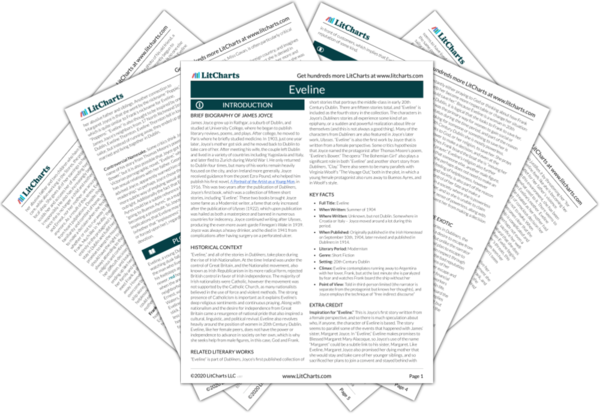“Eveline” addresses the subject of death both literally, as when Eveline lists off the people in her life who have died, and figuratively, in several other life events that become metaphors for death. She seems to be very aware of death, and the fact that she has been left behind, either by people dying or leaving.
While Eveline experiences many emotions related to her decision to leave Dublin, she never expresses any strong feelings about death. She refers to her mother’s death, saying life was better before she died, but never really expresses any grief or heartbreak in the text. This lack of emotion takes the drama out of the literal death. Eveline’s deceased neighbors and family members are essentially equal to those who moved away. This parallel between leaving Dublin and death implies that leaving Dublin is a metaphorical death. If Eveline leaves, she knows she will essentially become “dead” to everyone she leaves behind.
Marriage is also a metaphor for death since it signifies the end of an individual life and the beginning of a shared life. This is especially true for women in 20th-century Dublin, who essentially adopt their husband’s status and identity. It is a beginning but it is also an end, and this scares Eveline. The association of death and marriage is most obvious at the end of the story, when Eveline realizes that Frank will “drown her.” Frank is dragging her into the unknown “seas” and thus, in a way, ending her life, even if it’s only her life in Dublin.
Joyce communicates this idea of being dead while alive in the description of Eveline’s everyday life. She is thinking, yes, but not making active decisions. She is trapped in the monotony of caring for the children and her father, and as she admits, it is a hard life. There is a separation between those who stay in Dublin and those who leave, such as her father’s friend, the priest who moved to Melbourne, and whose photo is hanging on their wall. Her father takes great pride in casually announcing that he is in Melbourne now, because it signifies his success and implies that not many escape from Dublin. When Eveline makes her decision not to leave Dublin, she essentially gives up all possibility of change. She will not likely find another way to leave, and will be confined to her monotonous life, which Joyce equates with death. Joyce’s biggest critique of Dublin life seems to be this idea that Dubliners are trapped, forced to repeat their monotonous day-to-day tasks without ever really actively “living.” Life in Dublin, according to Joyce, is death.
The Many Forms of Death ThemeTracker

The Many Forms of Death Quotes in Eveline
Still they seemed to have been rather happy then… That was a long time ago; she and her brothers and sisters were all grown up; her mother was dead. Tizzie Dunn was dead, too, and the Waters had gone back to England. Everything changes. Now she was going to go away like the others, to leave her home.
Home! She looked round the room, reviewing all its familiar objects which she had dusted once a week for so many years, wondering where on earth all the dust came from. Perhaps she would never see again those familiar objects from which she had never dreamed of being divided.
And yet during all those years she had never found out the name of the priest whose yellowing photograph hung on the wall above the broken harmonium beside the colored print of the promises made to Blessed Margaret Mary Alacoque.
Her time was running out but she continued to sit by the window, leaning her head against the window curtain, inhaling the odour of dusty cretonne. Down far in the avenue she could hear a street organ playing. She knew the air. Strange that it should come that very night to remind her of the promise to her mother, her promise to keep the home together as long as she could.
As she mused the pitiful vision of her mother’s life laid its spell on the very quick of her being – that life of commonplace sacrifices closing in final craziness. She trembled as she heard again her mother’s voice saying constantly with foolish insistence: –Derevaun Seraun! Derevaun Seraun!
She stood up in a sudden impulse of terror. Escape! She must escape! Frank would save her. He would give her life, perhaps love, too. But she wanted to live. Why should she be unhappy? She had a right to happiness.
Could she still draw back after all he had done for her? Her distress awoke a nausea in her body and she kept moving her lips in silent fervent prayer. A bell clanged upon her heart. She felt him seize her hand: –Come! All the seas of the world tumbled about her heart. He was drawing her into them: he would drown her.
















